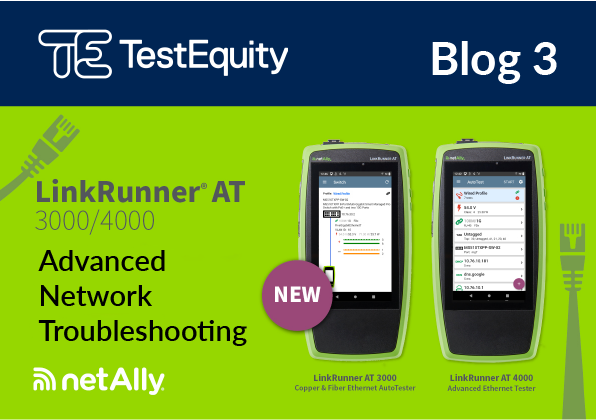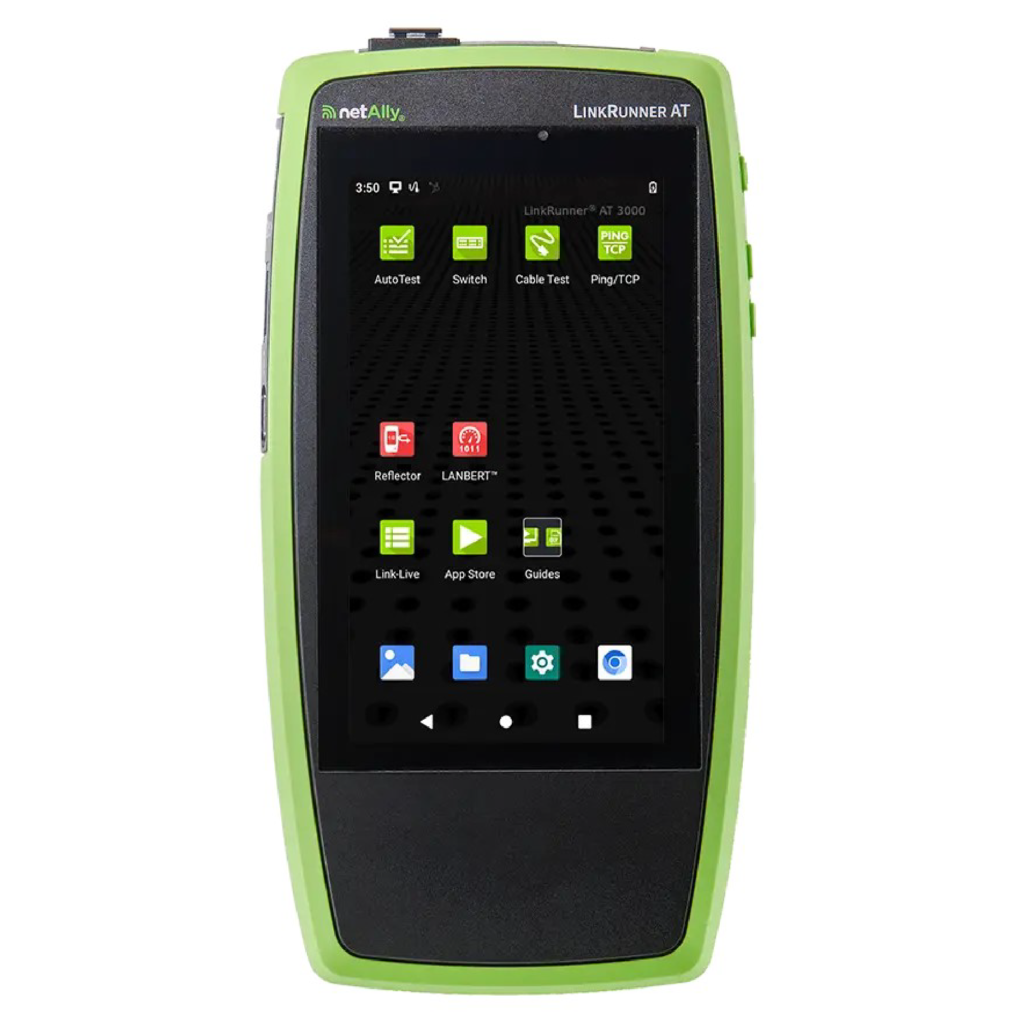As networks grow more complex, IT professionals need tools that offer more than just basic troubleshooting. The NetAlly’s LinkRunner AT 3000 and AT 4000 Ethernet Testers stand out by providing a comprehensive range of advanced features designed for those who manage large or intricate network environments. Whether you’re a senior network engineer or part of a large IT operations team, these testers can significantly reduce downtime, improve diagnostic accuracy, and streamline workflows.
In this blog, we’ll explore the advanced features and best practices for maximising the potential of the LinkRunner AT Ethernet Testers, helping you handle high-level network issues with ease.
1. Optimising PoE for High-Demand Environments
With the increasing number of PoE-dependent devices, such as VoIP phones, security cameras, and wireless access points, ensuring proper power allocation is critical in high-density environments. The LinkRunner AT 4000 tester’s advanced PoE testing capabilities allow you to:
- Test up to Class 8 PoE (90W) for high-power devices, such as pan-tilt-zoom (PTZ) cameras and digital signage.
- Detect PoE load fluctuations and verify stability over time, which is vital in environments with many power-hungry devices.
- Use the tester to ensure switches are delivering the correct power levels to each connected device, preventing power oversubscription that can cause devices to malfunction.
Pro Tip: When deploying a large number of PoE devices, test the PoE load on each switch port with the LinkRunner AT 4000 to ensure that all connected devices will maintain sufficient power even during peak usage.
2. Managing VLANs and Subnets Across Complex Networks
In modern enterprise networks, multiple VLANs and subnets are often implemented to segment traffic, increase security, and optimize bandwidth. The LinkRunner AT allows for quick identification of VLAN tagging and subnetting issues:
- Automatically detect the VLAN ID and priority assigned to a port.
- Verify VLAN configurations by testing against multiple VLANs for segmentation issues or incorrect assignments.
- Identify cross-subnet routing problems by analysing DHCP behaviour and validating the configuration of each segment.
Pro Tip: Use the AutoTest feature to instantly check if the VLAN ID and the IP address assigned match the expected configuration. This helps prevent misconfigurations when deploying new devices in a segmented network.
3. Advanced Cable Diagnostics and Testing: Going Beyond Basic Connectivity
Cable faults can be hard to track down, especially in large-scale environments with hundreds of connected devices. The LinkRunner AT offers advanced Time Domain Reflectometry (TDR) technology, which allows you to:
- Pinpoint exact cable faults (open, short, split pairs) with precise distance measurements.
- Test cables even when there is no link light—an invaluable tool when working with cable installations that haven’t yet been fully integrated.
- Map the wire topology to verify proper wiring and detect miswires or cross-connections, which can be difficult to troubleshoot without advanced tools.
Pro Tip: When troubleshooting intermittent network issues, use the TDR-based diagnostics to verify the physical integrity of the cabling, even in hidden or hard-to-access areas. This helps identify the root cause of the problem before replacing or re-terminating cables.
4. Network Discovery: Navigating Complex Infrastructures
For network professionals managing extensive or distributed infrastructures, the LinkRunner AT’s network discovery feature is an indispensable tool. It provides a quick and thorough overview of your network’s topology, helping you keep track of:
- The number and type of devices connected to each switch or router.
- Active services and their configurations, including DHCP, DNS, and SNMP.
- MAC address and IP address details of connected devices, which is critical when troubleshooting or adding new devices to a large network.
Pro Tip: Use the Network Discovery feature to run regular health checks across your infrastructure, mapping out all critical devices, and comparing the results to your baseline configuration to identify unauthorised devices or configuration drift.
5. Streamlining Multi-Site Operations with Link-Live
For IT teams responsible for multiple locations or large networks, the LinkRunner AT 4000’s integration with Link-Live is a game-changer. Link-Live provides:
- Automated test result uploads, ensuring all network tests are securely stored and accessible to team members from any location.
- Collaborative workflows, allowing teams to share diagnostic results and collaborate remotely on troubleshooting.
- Historical test data, enabling network administrators to compare past results and identify trends, which can help with long-term troubleshooting and maintenance planning.
Pro Tip: Use the batch test capability of Link-Live to run simultaneous tests across multiple network locations, ensuring that all areas are compliant with your organisation’s network performance standards.
6. Remote Site Verification: Speeding Up On-Site Troubleshooting
One of the biggest challenges in network management is handling remote sites where on-site expertise may be limited. With the LinkRunner AT 4000, network administrators can preconfigure tests and have them run automatically by less experienced technicians or even non-technical staff. The AutoTest function ensures:
- Correct test procedures are followed consistently.
- Test results are automatically uploaded to Link-Live, allowing off-site engineers to interpret and act on the data.
- Immediate identification of issues such as VLAN misconfigurations or faulty cabling, without the need for senior technicians to be on-site.
Pro Tip: For multi-site deployments, pre-configure AutoTests with VLAN and subnet validation settings tailored to each location’s specific needs. This allows field technicians to quickly confirm that devices are properly integrated into the network without in-depth expertise.
Conclusion: Mastering Advanced Troubleshooting with LinkRunner AT
The LinkRunner AT 3000 and AT 4000 Ethernet Testers aren’t just tools; they are essential for managing complex networks. Whether troubleshooting PoE issues, verifying VLAN configurations, or running diagnostic tests on cable integrity, these devices offer advanced functionality. They enable professionals to solve problems quickly and effectively.
By leveraging features like TDR diagnostics, Link-Live integration, and multi-site capabilities, network engineers can streamline workflows. These tools help reduce downtime and ensure networks run smoothly and efficiently. If you want to enhance your network troubleshooting, the LinkRunner AT series has the tools you need. They are designed for success in even the most challenging environments.
The difference between LinkRunner AT 3000 & AT 4000:
WANT TO BUY A LINKRUNNER AT 3000 OR AT 4000? CLICK ON THE LINK BELOW:
Testimonials
The LRAT AT 4000 has proven to be an exceptional addition to our toolbox. It has significantly reduced the time and cost associated with the troubleshooting process.
Paul S. – Engineer, Hallbeck IT – NetAlly Customer – From NetAlly*







